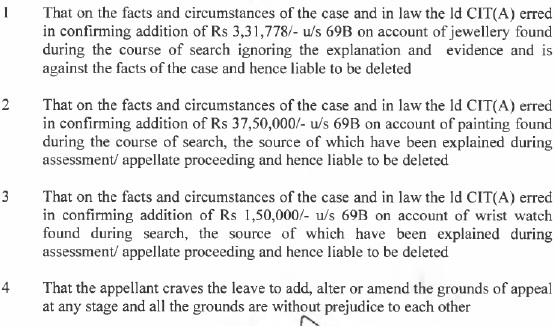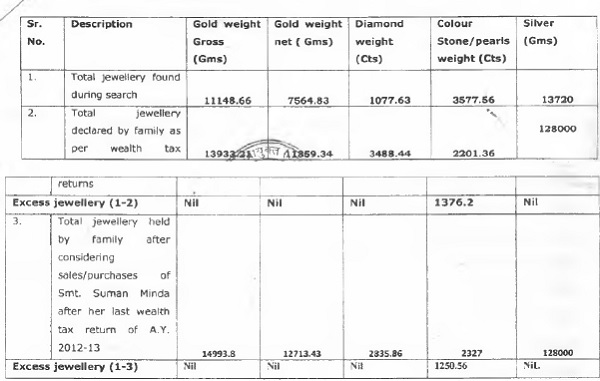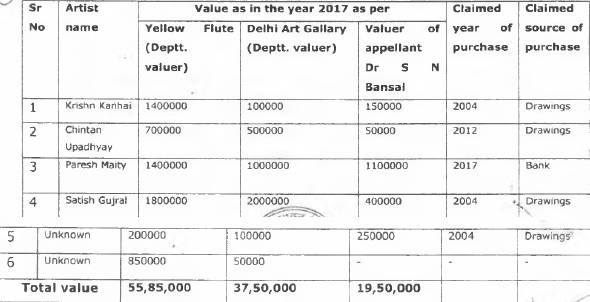Case Law Details
Nirmal Kumar Minda Vs ACIT (ITAT Delhi)
The ground No.2 relates to the addition of Rs.37.50 lacs u/s. 69B of the Act in respect of 6 paintings found at the residence of the assessee. The underlying facts in the impugned issue are that 6 paintings were found at the time of search which were got valued by the department from two different valuers. The assessee has also obtained valuation report independently valuation.
The AO adopted the valuation made by the yellow flute whereas the CIT(A) directed the AO to adopt the valuation of Delhi Art Gallery against this decision of the CIT(A) both the assessee and the revenue are in appeal before us.
The Counsel for the assessee vehemently stated that no adverse findings have been given on the valuation report of the It is the say of the Counsel that the departmental valuation officer has not even pointed out the year of paintings.
The Counsel further stated that one of the paintings from Paresh Maity was purchased by account payee cheque. In so far as the source of investment is concerned the Counsel pointed out that the house hold expenses and the withdrawal chart exhibited at pages 202 to 204 of the paper book and stated that the huge withdrawals for house hold expenses are sufficient to cover the investment.
Per contra the DR strongly supported the findings of the AO and read the operative part of the assessment order.
We have carefully considered the orders of the authorities The difference in the valuation can be seen from the chart exhibited here in above. It can be seen that the assessee has claimed to have purchased the paintings in the year 2004, 2012 and 2017 whereas the departmental valuation officer has not mentioned the year of purchase in their respective valuation report. We find that the DVO has also not pointed out any defect in the valuation report filed by the assessee nor there is any evidence on record to show that the AO has examined the valuation of the assessee. It can be seen from the two DVO’s report that both the valuer of the department have valued the painting differently. This show that the opinion of the experts can also differ on the same set of facts. In our considered opinion if the paintings are purchased in the year 2004 then the value cannot be added in the year under consideration more over even the department valuers have not expressed any reservations on the year of purchase shown by the valuer of the assessee, we do not find any reason to take any adverse view on that.
FULL TEXT OF THE ORDER OF ITAT DELHI
ITA No.1511/Del/2020 and 1060/Del/2021 are cross appeals by the assessee and the revenue preferred against the order of the CIT(A)-26, New Delhi dated 26.06.2020 pertaining to A.Y.2018-19.
2. These cross appeals were heard together and are disposed of by this common order for the sake of convenience and brevity.
3. We will first take up ITA No.151 1/Del/2020 assessee’s
4. The grievance of the assessee read as under :-

5. Briefly stated the facts of the case are that a search and seizure operation u/s. 132 of the Act was conducted on 06.20 17. During the course of the search operation jewellery, Silver articles were found at the residence of the assessee amounting to Rs.2,64,35,029/- was seized from the premises. During the course of assessment proceedings the assessee was asked to explain the source of acquisition of the above mentioned jewellery with documentary evidence. The assessee explained that jewellery found during the course of search is part of Wealth Tax return/ books of accounts of the assessee and filed a detailed re-conciliation of jewellery with the Wealth Tax Return / books of accounts.
6. The reply of the assessee did not find any favour with the AO who was of the firm belief that the assessee has not submitted source of payment made for the purchase of the jewellery item and the assessee has not been able to reconcile the various items of jewellery with the valuation report. The AO made addition of 26435029/- u/s.69B r.w.s. 115BE of the Act. The addition was challenged before the CIT(A) and once again a detailed reconciliation statement was furnished explaining the jewellery shown in the Wealth Tax Return and found at the time of search.
7. After considering the facts and the submissions the CIT(A) was satisfied with the reconciliation but was of the opinion that the colour stone/ pearls have not been properly reconciled and sustained the addition to the extent of Rs.33 1778/-thereby giving relief of Rs.26 103251/-. Against this finding of the CIT(A) both the assessee and the revenue are in appeal before us.
8. The Counsel for the assessee reiterated what has been stated before the lower authorities.
9. The DR strongly supported the findings of the AO.
10. We have given a thoughtful consideration to the orders of the authorities below. The undisputed fact is that all the family members are residing at one place and can be considered as one family unit. The comparative chart of overall jewellery found during search and declared in the Wealth Tax Return of the family members is as under :-

11. From the above chart it can be seen that the jewellery declared/ disclosed by the family as one unit is more than the jewellery found during search.
12. In our considered opinion in the light of the aforementioned chart we do not find any merit in making any addition on account of unexplained jewellery.
13. We further find that the assessee has given item wise reconciliation of Wealth Tax Return items with the valuation report prepared during search and the AO has not pointed out any specific defect in the reconciliation but had given general remarks that items are not matching. It is customary amongst the married women to keep on changing the jewellery as and when new designs come in the market. The fact that needs to be considered is that the weight of the jewellery more or less remained the same though the design may change. Sometimes new stones are engraved and sometimes the engraved stones are taken out of the jewellery. However, the status of the family, the return of income of the family has to be kept in mind.
14. It would be pertinent to refer to the judgment of the Hon’ble Jurisdictional High Court of Delhi in the case of Ashok Chaddha Vs. ITO 14 taxman.com57 wherein Hon’ble High Court has highlighted realities of life by holding as under :-
(i) “Judgement of the Hon’ble High Court of Delhi in the case of Ashok Chaddha (supra) wherein the Hon’ble High Court has accepted the jewellery of 906.60 grams in the case of married lady even without documentary evidence as the denying the explanation would tantamount to overlooking the realities of life by holding as under:—
“As far as addition qua jewellery is concerned, during the course of search, jewellery weighing grams of the value amounting to Rs. 6,93,582 was found. The appellant’s explanation was that he was married about 25 years back and the jewellery comprised “streedhan” of Smt. Jyoti Chad ha, his wife and other small items jewellery subsequently purchased and accumulated over the /ears. However, the Assessing Officer did not accept the above explanation on the ground that documentary evidence regarding family status and their financial position was not furnished by the appellant. The Assessing Officer accepted 400 grams of jewellery as explained and treated jewellery amounting to 506.900 grams as unexplained and made an ad hoc addition of Rs. 3.87,364 tinder section 69A of the Act working on unexplained jewellery, by applying average rate of the total jewellery found. The relevant portion of the assessment order reads as follows:—
“a very reasonable allowance of ownership of gold jewellery to the extent of 400 grams is considered reasonable and the balance quantity of 506 grams by applying average rate, the unexplained gold jewellery is considered at Rs. 3,87,364 (506/900 x 6,93,582) u/s 69A of the Act.”
The CIT (A) confirmed this addition stating that the Assessing Officer had been fair in accepting the part of jewellery as unexplained. The ITAT has also endorsed the aforesaid view. Learned counsel for appellant Ms. Kapila submitted that there was no basis for the Assessing Officer to accept the ownership of the gold jewellery to the extent of 400 grams only as “reasonable allowance” and treat the remaining jewellery of Rs. 506.900 as unexplained. She also submitted that another glaring fact ignored by the Assessing Officer as well as other authorities was that as the department had conducted a search of all the financial dealings which were within his kr owledge and no paper or document was found to indicate that this jewellery belonged to the appellant and that it was undisclosed income of the assessment year 2006-0 7. In a search operation, no scope is left with the tax department to make addition on subjective guess work, conjectures and sumises. It was also argued that jewellery is “streedhan” of the assessee’s wife, evidenced in the foim of declaration which was ftimished by mother-in-law of the assessee stating that she had given the jewellery in question to her daughter. She argued that it is a normal custom for a woman to receive jewellery in the form of marriage and other occasions such as birth of a child. The assessee had been married more than 25-30 years and acquisition of the jewellery of 906.900 grams could not be treated as excessive.
3. Learned Counsel for the respondent on the other hand relied upon the reasoning given by the authorities below. After considering the aforesaid submissions we are of the view that addition made is totally arbitrary and is not founded on any cogent basis or evidence. We have to keep in mind that the assessee was married for more than 25-30 The jewellery in question is not very substantial. ‘The learned counsel for the appellant/ assessee is correct in her submission that it is a normal custom for woman to receive jewellery in the form of “streedhan” or on other occasions such as birth of a child etc. Collecting jewellery of 906.900 grams by a woman in a married life of 25-30 years is not abnormal. Furthermore, there was no valid and / or proper yardstick adopted by the Assessing Officer to treat only 400 grams as “reasonable allowance” and treat the other as “unexplained”. Matter would have been different if the quantum and value of the jewellery found was substantial.
4. We are, therefore, of the opinion that the findings of the Tribunal are totally perverse and far from the realities of life. In the peculiar facts of this case we answer the question in favour of the assessee and against the revenue thereby deleting the aforesaid addition of Rs. 3,87,364.”
15. In the light of the aforementioned judgment of the Hon’ble Delhi High Court, the withdrawals made month after month cannot be brushed aside lightly and which are evident from 202 to 204 of the paper book and it can be seen that the withdrawals are enormous and needless to mention the returned income of the assessee is Rs. 14.73 crores. The withdrawals and the returned income speak volumes about the richness of the family.
16. Considering all these facts in totality and in particular the wealth tax returns viz-a-viz the jewellery found. We do not find any merit in the impugned addition made by the AO we accordingly direct the AO to delete the entire addition of 26435029/- thereby allowing ground No.1 of assessee’s appeal and dismissing ground No.1 of revenue’s appeal.
17. The ground No.2 relates to the addition of Rs.37.50 lacs u/s. 69B of the Act in respect of 6 paintings found at the residence of the assessee. The underlying facts in the impugned issue are that 6 paintings were found at the time of search which were got valued by the department from two different valuers. The assessee has also obtained valuation report independently valuation can be understood from the following chart :-

18. The AO adopted the valuation made by the yellow flute whereas the CIT(A) directed the AO to adopt the valuation of Delhi Art Gallery against this decision of the CIT(A) both the assessee and the revenue are in appeal before us.
19. The Counsel for the assessee vehemently stated that no adverse findings have been given on the valuation report of the It is the say of the Counsel that the departmental valuation officer has not even pointed out the year of paintings.
20. The Counsel further stated that one of the paintings from Paresh Maity was purchased by account payee cheque. In so far as the source of investment is concerned the Counsel pointed out that the house hold expenses and the withdrawal chart exhibited at pages 202 to 204 of the paper book and stated that the huge withdrawals for house hold expenses are sufficient to cover the investment.
21. Per contra the DR strongly supported the findings of the AO and read the operative part of the assessment order.
22. We have carefully considered the orders of the authorities The difference in the valuation can be seen from the chart exhibited here in above. It can be seen that the assessee has claimed to have purchased the paintings in the year 2004, 2012 and 2017 whereas the departmental valuation officer has not mentioned the year of purchase in their respective valuation report. We find that the DVO has also not pointed out any defect in the valuation report filed by the assessee nor there is any evidence on record to show that the AO has examined the valuation of the assessee. It can be seen from the two DVO’s report that both the valuer of the department have valued the painting differently. This show that the opinion of the experts can also differ on the same set of facts. In our considered opinion if the paintings are purchased in the year 2004 then the value cannot be added in the year under consideration more over even the department valuers have not expressed any reservations on the year of purchase shown by the valuer of the assessee, we do not find any reason to take any adverse view on that. The status of the family have already been explained while adjudicating ground No.1 (supra). Considering the facts in totality we do not find any merits in the impugned addition of Rs. 5585000/-. We direct the AO to delete the same thereby allowing the ground No.2 of assesee’s appeal and dismissing the ground No.2 of revenue’s appeal ground No.3 relates to the addition of Rs. 1.50 lacs u/s.69B of seized wrist watches.
23. The under lying facts are that during the search proceedings the wrist watches of Rs. 1.50 lacs were seized and the assessee was asked to explain the source of acquisition with documentary evidences in its reply the assessee explained that the assessee and their family members are regular income tax assessee and the returned income has been filed for A.Y.2017-18 at Rs.9.50 crores and have sufficient household withdrawals, therefore, no addition should be made on this account. The explanation of the assessee was dismissed by the AO who was of the opinion that the assessee could not explain the source of investment and made the addition of Rs. 1.50 lacs.
24. The status of the family, the returned income and the withdrawals have been discussed by us while adjudicating ground No.1 of assesse’s appeal in detail wherein reference has been made to the judgment of the Hon’ble High court of Delhi of Ashok Chaddha (supra). For our detailed discussion there in considering the status and the richness of the family we do not find any merit in the impugned addition of Rs. 1.50 lacs and the AO is directed to delete the same. Ground No.3 of assessee’s appeal is allowed.
25. In the result, the appeal of the assessee is allowed and that of the revenue is dismissed.
Order pronounced in the open court on 03.05.2023.




